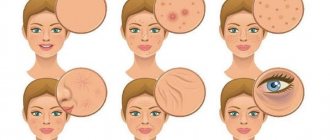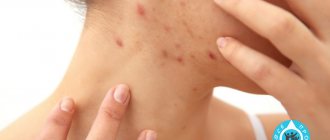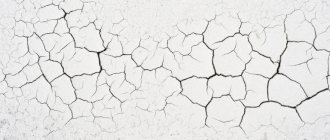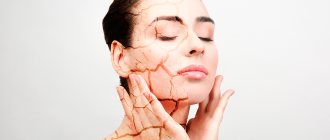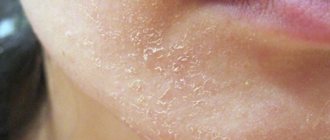Types of skin irregularities and causes of their appearance
You need to know the enemy by sight. Therefore, first learn about various skin diseases that are accompanied by structural disturbances, deformation of the surface layer of the dermis and the formation of bumpy facial skin.
- Enlarged pores - ducts of sweat and sebaceous glands emerge through small points on the skin (pores). When there is excess production, the pores stretch, become inflamed at the edges, and rolls of dense tissue form.
- Acne and its consequences - It has been proven that the main cause of acne is hormonal imbalance. The body has an increased sensitivity to the sex hormone testosterone and responds by increasing the production of fat by the sebaceous glands. As a result, the ducts of the glands become clogged, and a dense, enlarging formation appears in this place. If an infection gets into the ducts, rapid infection occurs and an inflammatory process develops with ulcers and dense bumps on the surface. Demodicosis leads to such consequences. This disease is caused by tiny mites that penetrate enlarged pores or sebaceous glands.
- Scars and cicatrices - occur as a result of cuts, injuries, burns of the face, and prolonged inflammatory processes. In places of scars, the skin loses its collagen, elastic tissues are replaced by dense fibrous inserts. They deform the surface and disrupt all functions of the epidermis.
- Hyperpigmentation - ultraviolet rays in high doses cause sunburn of tissue. As a result, not only rough spots appear, but also the production of your own hyaluronic acid, and, consequently, collagen synthesis stops. All skin restoration processes are disrupted.
- Inflammation - any inflammatory processes require gentle treatment. “It will go away on its own” means that the process may result in the appearance of scars and unwanted deformities.
These are the main reasons. You can calculate them yourself, but you still cannot do without additional diagnostics, so do not neglect the capabilities of modern laboratories in cosmetology.
Many cosmetic and health problems are reflected on the face and this cannot but upset us. Generally speaking, the causes of facial lumpiness are:
- sometimes the face becomes uneven in the place where the ducts of the sebaceous and sweat glands emerge through the enlarged pores (with an excess of skin secretion, the pores become even wider, their inflamed edges form compactions on the surface of the dermis);
- It happens that alignment after acne is the main reason for the formation of the “orange peel” problem (the consequences of acne, when the ducts of the skin glands become clogged, seals grow and lumpiness can spread across the face);
- the dermis loses its elasticity, and fibrous inserts deform its surface in places of scars, cuts, burns, long-term inflammatory processes, hence the problem of tuberosity;
- Besides everything else, uneven skin is the result of hyperpigmentation (the merciless sun scorches the dermis and rough patches grow on the tissue).
Types of lumpiness on the face and the causes of their occurrence
Violation of the structure of the surface epithelium on the face varies.
Most often, enlarged pores are a skin problem that can be inherited, or a malfunction of the sebaceous glands. This mainly applies to oily skin types. Excessive sweating expands the pores and increases the risk of contamination. Purulent pimples that form on the skin are caused by mites. They penetrate through large pores and cause irritation and infection. Blackheads can be white or in the form of blackheads. White ones often become inflamed, but black ones, colored by melanin by oxidation, rarely.
But they violate the surface of the face in any case. Dry and flaky dermis of the face is susceptible to the appearance of blackheads.
Skin porosity increases with active physical activity, for example in athletes. Exhausting workouts force the sebaceous glands to work more actively and thereby provoke their expansion.
Inflammatory processes of a temporary nature appear on the face in the form of a bumpy surface and sometimes do not go away without a trace.
Applying cosmetics to inflamed areas of facial tissue provokes greater inflammation and clogging of pores, which can lead to a breeding ground for purulent acne. Also, cosmetics with an oily texture can result in allergic reactions that cause skin rashes.
Cuts and scars on the face leave their marks. In places where scars form, the elasticity of the skin is impaired, as a result, it becomes deformed and becomes lumpy.
Sunburn can also damage the condition of the skin. In addition to damaging the top layer, the body at the burn site stops producing collagen, which supports the restoration of the epidermis. Pigment spots and post-burn scars form, which have to be hidden with cosmetics. Changes in climatic conditions, stress, allergies to cosmetics and some medications can also cause skin rashes on the face.
Firstly, lumpy facial skin may be the result of some other disease - for example, chickenpox or a pustular infection. After all, it’s understandable; acne forms deep under the skin.
Secondly, lumpy facial skin may be the result of some mechanical impact - for example, tissue ruptures, chopped and scalped wounds due to various injuries.
You need to know the enemy by sight. Therefore, first learn about various skin diseases that are accompanied by structural disturbances, deformation of the surface layer of the dermis and the formation of bumpy facial skin.
- Enlarged pores - ducts of sweat and sebaceous glands emerge through small points on the skin (pores). When there is excess production, the pores stretch, become inflamed at the edges, and rolls of dense tissue form.
- Acne and its consequences - It has been proven that the main cause of acne is hormonal imbalance. The body has an increased sensitivity to the sex hormone testosterone and responds by increasing the production of fat by the sebaceous glands. As a result, the ducts of the glands become clogged, and a dense, enlarging formation appears in this place. If an infection gets into the ducts, rapid infection occurs and an inflammatory process develops with ulcers and dense bumps on the surface. Demodicosis leads to such consequences. This disease is caused by tiny mites that penetrate enlarged pores or sebaceous glands.
- Scars and cicatrices - occur as a result of cuts, injuries, burns of the face, and prolonged inflammatory processes. In places of scars, the skin loses its collagen, elastic tissues are replaced by dense fibrous inserts. They deform the surface and disrupt all functions of the epidermis.
- Hyperpigmentation - ultraviolet rays in high doses cause sunburn of tissue. As a result, not only rough spots appear, but also the production of your own hyaluronic acid, and, consequently, collagen synthesis stops. All skin restoration processes are disrupted.
- Inflammation - any inflammatory processes require gentle treatment. “It will go away on its own” means that the process may result in the appearance of scars and unwanted deformities.
DETAILS: Human papillomavirus on the cervix: treatment
These are the main reasons. You can calculate them yourself, but you still cannot do without additional diagnostics, so do not neglect the capabilities of modern laboratories in cosmetology.
Many cosmetic and health problems are reflected on the face and this cannot but upset us. Generally speaking, the causes of facial lumpiness are:
- sometimes the face becomes uneven in the place where the ducts of the sebaceous and sweat glands emerge through the enlarged pores (with an excess of skin secretion, the pores become even wider, their inflamed edges form compactions on the surface of the dermis);
- It happens that alignment after acne is the main reason for the formation of the “orange peel” problem (the consequences of acne, when the ducts of the skin glands become clogged, seals grow and lumpiness can spread across the face);
- the dermis loses its elasticity, and fibrous inserts deform its surface in places of scars, cuts, burns, long-term inflammatory processes, hence the problem of tuberosity;
- Besides everything else, uneven skin is the result of hyperpigmentation (the merciless sun scorches the dermis and rough patches grow on the tissue).
Subcutaneous (internal, painful) acne on the forehead
A large subcutaneous pimple on the forehead, even in the singular, causes discomfort and pain. They are quite large and dense in size.
Causes
If a large pimple pops up, there are the following reasons:
- colds;
- inappropriate skin care;
- active work of the sebaceous glands;
- hormonal imbalances in the body in men and women;
- reproduction of bacteria in clogged pores;
- using cosmetics that have expired or are of poor quality to begin with.
Symptoms
A pimple under the skin on the forehead appears gradually. First, a small red bump appears on the skin, which is not yet painful. Then it begins to thicken and increase in size. In this case, pain appears when touching it.
The thing is that pus grows inside. This process takes about 2-3 weeks. When the maturation of a subcutaneous pimple comes to an end, a white head with pus inside appears on the surface of the lump.
Treatment
Internal pimples can be treated with proper treatment and proper skin care. Necessary:
- limit the consumption of flour, sweet, spicy, fatty, smoked foods, as such products provoke excessive secretion of sebum;
- use antiseptics to treat pimples;
- temporarily stop using foundation, powder and other cosmetics that clog the pores on the forehead;
- apply an ointment to the subcutaneous formation that draws out pus;
- if necessary, visit a doctor to determine the true cause of such an inflammatory process.
Small pimples on forehead
Small pimples on the face appear on the forehead in the form of white rashes, which are also called milia, comedones, and also in the form of red pimples. The latter can be with or without inflammation.
Causes
Why small pimples appear on the forehead - the reasons are as follows:
- parasites in the human body;
- in girls and women due to a malfunction of hormones;
- unfavorable environment, polluted atmosphere;
- hereditary predisposition;
- poor nutrition, disruption of the gastrointestinal tract;
- lack of sleep due to insomnia, during exams, etc.
Symptoms
Small pimples on the forehead appear in large numbers at once. The rash is usually painless, but painful, inflamed rashes may also appear.
Treatment
Various methods and remedies can help with small pimples. However, you should first visit a dermatologist, gynecologist, endocrinologist, allergist, and cosmetologist.
Usually medications are prescribed that dry out pimples: Baziron AS, Zinerit, etc.
Establishing proper nutrition and giving up bad habits (smoking, alcohol, etc.) will also help.
At home, you can steam your face over a bath of hot water. For greater effect, the face is held over a hot herbal decoction. It is safe to use calendula tincture to wipe your face, as well as wipe the skin on your forehead with aloe juice.
Lumpy skin in a child
Well, it would be completely unfair to keep silent in this article about our younger generation - our children. First of all, lumpy skin is found on the child’s hand. Why? And you remember yourself as a child - they pulled potatoes out of the fire, launched boats in the water, caught frogs, sculpted resin figures... and where did you put those hands, what did you do with them!
As a result, spots (macula), papules, blisters, blisters, crusts, erosions and ulcers appear on the skin of children. Having problems? Contact your pediatrician immediately. This will save your child from suffering and, if treated correctly and in a timely manner, will allow him to keep his skin smooth and elastic into old age.
You can leave reviews or tell us about how you overcame the disease on our forum by following this link
DETAILS: HPV extended screening 15 kvm what is it
How to deal with uneven facial skin: home remedies
First, you need to adhere to a strict diet: foods that promote sebum formation are excluded from food. Fatty, sweet and flour dishes, all kinds of pickles and marinades, hot seasonings, and alcoholic drinks are limited. It is allowed to eat dairy products and eat a lot of vegetables and fruits.
Vitamins A (contain red and orange vegetables and fruits) and E (all nuts except peanuts, the best are almonds) are shown. Masks and lotions from folk remedies are convenient for home use for lumpy skin. They are aimed at softening the bumps, moisturizing and nourishing the epidermis, and normalizing the functioning of the sebaceous glands. Here are the most popular and tested recipes.
- Aloe leaf lotion - first leave the leaves in the refrigerator for two hours, then pour a tablespoon of crushed leaves into a glass of hot water and leave for two hours. You need to wipe your face several times a day every day.
- A tincture of white lily petals is prepared as follows: place a full jar of petals tightly, pour in vodka, and put in a dark place for two weeks. Use the lotion daily at night to treat your face.
- To eliminate demodicosis, it is recommended to use an aqueous infusion of juniper berries or wormwood herb (infuse one tablespoon per glass of boiling water for four hours). After degreasing the skin with any alcohol-containing product, apply lotions to the bumpy areas.
- Laser peeling or facial resurfacing uses the property of a laser beam to stimulate the skin's production of its own collagen. This allows you to remove shallow wrinkles and scars. The procedure lasts twenty minutes and is painless. After finishing, the skin turns red. Recovery takes seven to ten days. The method can only be performed in a trusted clinic by an experienced doctor. To eliminate deep bumps, the penetration of the rays must be sufficient. Doctors know the capabilities of their device and will recommend the mode and frequency of procedures.
- Ultrasonic cleaning - with the help of hardware ultrasound, impaired functions of the skin are restored (inflammation is relieved, allergic reactions are eliminated, collagen and elastin synthesis is enhanced). Cleaning removes dead skin cells of the epidermis, smoothes it, and promotes the penetration of active ingredients from masks and creams. It is recommended as a cleansing procedure for relatively unpronounced skin unevenness.
- The method of disincrustation using galvanic current allows for cleansing at a deeper level and gets rid of old seals. First, an alkaline solution is applied and the treatment is first carried out with a negative current; after seven to ten minutes the charge changes to positive. This relaxes the ducts of the sebaceous glands, allows the accumulated secretions to escape, and relieves inflammation.
- Mesotherapy - the active ingredient is one of the preparations based on hyaluronic acid. It is administered by injection with a thin needle into the tissue according to the scheme. In this case, under visual control, the missing agent responsible for tissue reconstruction, hydration, and elasticity is returned to the skin. There is a fight against inflammatory changes. A course of treatment requires six to eight procedures. It needs to be repeated twice a year.
- Chemical peeling. Deep resurfacing is a procedure at the surgical level, performed in a hospital setting once in a lifetime. Requires a fairly long recovery period. In cosmetic hospitals, superficial chemical peeling using acids (lactic, mandelic, glycolic, salicylic) is widely used. Allows you to remove unnecessary dead cells. Rejuvenate tissues and straighten tubercles, activating its own regeneration processes. Before the procedure, preparation is necessary using products with weak fruit acids. This improves the effect of chemical peeling. It is recommended in the autumn, as thin skin becomes extremely susceptible to sunlight.
Peeling of bumpy facial skin
The most effective way to make the bumpy skin of the nose, chin, forehead and the whole face look decent is to peel the face.
Facial peeling is cleansing, or, more precisely, exfoliation of the skin from keratinized scales of the epidermis, due to which it is evened out. Peeling can be done at home using products you make yourself or buy at a cosmetic store.
Among homemade products, we can separately mention a mask with oatmeal and a scrub made from a mixture of salt and soda as the most effective and tested by a large number of satisfied owners of beautiful skin. However, home remedies are, of course, good, but if the skin is too neglected, then there is no way to do without a trip to a beauty salon and professional cleaning.
What skin smoothing services can modern beauty salons offer?
To make lumpy skin on the forehead or lumpy skin on the chin and cheeks smoother, use chemical facial cleansing, also known as chemical peeling. This procedure, of course, is not very cheap, and it will take quite a lot of time, but its effectiveness is beyond any doubt. Chemical peeling is carried out in several stages, it usually takes several days.
However, in each individual case, the time for using chemical reagents may vary depending on the condition of the skin. A special chemical composition is applied daily to the skin, softens it to a certain state, and then it is all removed using special products, revealing healthy and absolutely smooth skin.
But let’s not forget about the contraindications to this procedure, which the attending doctor simply must warn you about: general intolerance to the components or too sensitive skin. In any case, chemical peeling is a procedure that requires consultation with a doctor.
By the way, the doctor should prescribe something if there is lumpy skin around the eyes and lumpy skin under the eyes, since these areas have very delicate skin that cannot be exfoliated so as not to injure it.
If for some reason chemical treatment of the skin is not suitable and in cases of minimal unevenness, laser resurfacing of the facial skin will be an excellent solution. Yes, a little expensive, but effective and fast!
Clay is an assistant against lumpy skin on the face
In addition to cleansing masks and scrubs, the use of ordinary clay gives good results. Healing clay is an excellent base for a mask, which also has a slight effect of dissolving the upper layer of the epidermis. This clay mask should be used regularly, at least twice a week, otherwise the cosmetic effect that you want to expect will not happen.
Believe it or not, this incredibly effective mask is extremely easy to make!
So, making such a mask is simple: you need to dilute the dry clay with water until a paste forms. You can also add lemon juice, since fruit acids are an excellent remedy that will make lumpy skin on the cheeks, lumpy skin on the forehead and the entire face definitely smoother and healthier.
How to get rid of bumps and irregularities
Small bumps that appear on the face cause a lot of grief. The treatment method depends on the cause of the disease, so you will have to check the functioning of the following organs:
- gallbladder;
- thyroid gland.
Often you have to donate urine and feces, check hormone levels and cholesterol levels in the blood. If it is suspected, a scraping is made, which the doctor examines under a microscope.
Without an accurate diagnosis, it will not be possible to eliminate the defect, so avoid self-medication. If you squeeze out subcutaneous pimples or on your own, you risk getting scars on your face. An adequate measure would be to contact a specialist and preventive measures, which can be carried out at home.
How to get rid of subcutaneous tubercles?
Treatment methods depend on the reason for the appearance of pimples on the skin and what they are. Often, with such a problem, it is recommended to check the condition of the gallbladder, thyroid gland, stomach and intestines. Most likely, in order to identify the cause, you will need to take a lot of tests: blood for hormones, cholesterol levels and other indicators, urine, feces, in some cases (for example, if you suspect demodicosis) - do a skin scraping analysis.
The reasons can be different: from staphylococcus infection to banal improper skin care, so it is better not to self-medicate. If you act on the wrong cause, there will be no result. As treatment, the doctor may prescribe the use of hormonal drugs, antibiotics, sedatives, the use of local therapy products, for example, Baziron, Skinoren, Zerkalina, Zenerit, Differin, etc. In addition, a dermatologist may suggest that you remove the subcutaneous tubercles using one of the following methods:
- electrocoagulation;
- laser treatment;
- ozone therapy;
- professional cosmetological facial cleansing;
- superficial skin peeling;
- mechanical removal with special medical instruments.
The main rule of treatment is do not try to open the “subcutaneous tissue” yourself. This will only make the problem worse. The infection can spread to healthy skin, and an unsightly scar will remain in place of the squeezed out bumps. In addition, as a rule, the subcutaneous tubercles do not suppurate, and there is practically no content inside them, so there is, in fact, nothing to squeeze out there.
How to get rid of a bump on your face
How to remove dry calluses on the footHow to remove calluses on the feet at home
First of all, you need to seek qualified medical help. Depending on the tumor, appropriate treatment is prescribed. In some situations, the use of topical agents is sufficient, and sometimes antibacterial therapy is required.
The doctor’s first goal is to determine the tumor and its nature. In other words, it determines whether the lump is benign or malignant and whether it is life-threatening. Some types of benign lipomas appear quickly, but also quickly disappear on their own.
Treatment tactics depending on the type of lump on the face under the skin:
- If a small abscess is detected, it is punctured. The purulent masses are pumped out using a syringe, then the cavity is washed with a medicinal solution. A novocaine solution containing antibiotics is administered. Additionally, alcohol lotions and Vishnevsky ointment are prescribed;
- The method of treating an intradermal cyst is determined by its size. If the size is minimal, then removal is not recommended. Other seals require consultation with several specialists - a surgeon, a cosmetologist, and must be eradicated using radio wave or laser methods in order to minimize trauma;
- Hygroma is removed mechanically. A minimally invasive technique is used to eliminate the subsequent formation of scars and scars.
In the presence of infectious processes, antibacterial therapy is prescribed after testing for sensitivity to groups of drugs. If the lump appears due to inflammatory processes, anti-inflammatory medications are recommended.
Local agents
When the lump is single and does not cause pain, you can use simple methods at home to help “pull it out.” They help in cases where there are accumulations inside the neoplasms - pus, serous fluid, etc.
Preparations to combat subcutaneous lumps:
- Ichthyol ointment is applied to the affected area at least twice a day. The compress will enhance the therapeutic effect; it is recommended to do it at night. A contraindication for use is organic intolerance to the active substances.
- Cream Baziron, Differin (as in the photo) and similar drugs effectively stop inflammatory processes and are characterized by regenerating properties. During pregnancy, it is better not to use it.
- Vishnevsky ointment is a cheap and simple method that draws the pathological contents out of the cones. The price is approximately 100 rubles.
- Dalacin is an antibacterial drug that helps in cases where the cause of compaction is bacteria.
If a lump appears, there is swelling around it, and the temperature has risen, you should immediately visit a doctor. The purulent process can lead to blood poisoning and death.
Treatment with unconventional methods
Along with pharmaceutical drugs, effective folk remedies are often used, available for use at home:
- A lotion based on aloe juice helps get rid of pimples with purulent contents that do not “ripen” on their own. Squeeze a few drops of juice onto a cotton swab, apply to the affected area, and secure with a band-aid. Ideally, the manipulation is carried out throughout the night;
- Tea tree oil has many therapeutic effects. It is applied pointwise up to 5 times a day;
- If there is swelling around the lump, crush three aspirin tablets, add a small amount of clean water, and apply to the lump for 30 minutes. Then rinse with warm water and treat with liquid antiseptic;
- Lubricate the problem area with vegetable oil, then apply minced garlic. Place a bandage on top. The procedure time is no more than 20 minutes.
Keeping garlic on the skin for a long time can lead to damage, followed by burning, itching, pain and redness.
If home methods do not help get rid of lumps under the skin within one week, and discomfort and negative symptoms are detected, then the only way out is to visit a medical specialist - a cosmetologist, dermatologist, or surgeon.
As a preventative measure, it is necessary to follow basic hygiene rules, choose the right facial skin care products, monitor your eating habits and maintain a daily routine. Simple measures will not require much effort and will prevent the formation of bumps.
Prevention methods
To make your skin delight you with its smoothness and even complexion, try to follow the following recommendations:
- If your skin is prone to uneven skin, pay special attention to the cleansing step. Use exfoliating gommages and scrubs. But on the contrary, you should avoid alcohol-containing lotions. They dry out the epidermis, causing the sebaceous glands to produce sebum in double volume. This only causes clogged pores.
- Review your diet. If you eat sweets and cakes every day, often have processed dinners and often drink alcoholic beverages, your skin is unlikely to look perfect. Include more greens, vegetables and fruits in your diet, and take a course of multivitamins.
- If possible, avoid bright makeup. Often, subcutaneous comedones are a reaction to the constant use of foundation. Also, the appearance of bumps can be caused by the use of cream eye shadow. Give preference to dry, crumbly options, and instead of foundation, apply mineral powder. It is much more suitable for problem skin.
White bumps on the face - wen
During gestation, a special hormone accumulates in the child. Its excess leads to the appearance of a rash. It resembles small white pearls. This acne is a reaction to changing external conditions.
Milium appears due to the fact that the sebaceous glands are still immature. These small white bumps on the face are completely harmless. They do not require special treatment or care. Acne will go away in a couple of months. Milia will disappear when the baby's sebaceous ducts open.
So, do you have bumps under the skin on your face? What is this? Lipomas or lipomas are special formations that consist of the corresponding tissue. They do not cause any painful sensations. The fatty tissue rises slightly above the surface of the skin and cannot dissolve or disappear on its own. But you can’t squeeze him out either - such attempts are extremely dangerous.
Sometimes a lipoma retains its original size for a long time. In other cases it grows slowly. If such a nuisance appears on the face, it causes a lot of aesthetic troubles.
